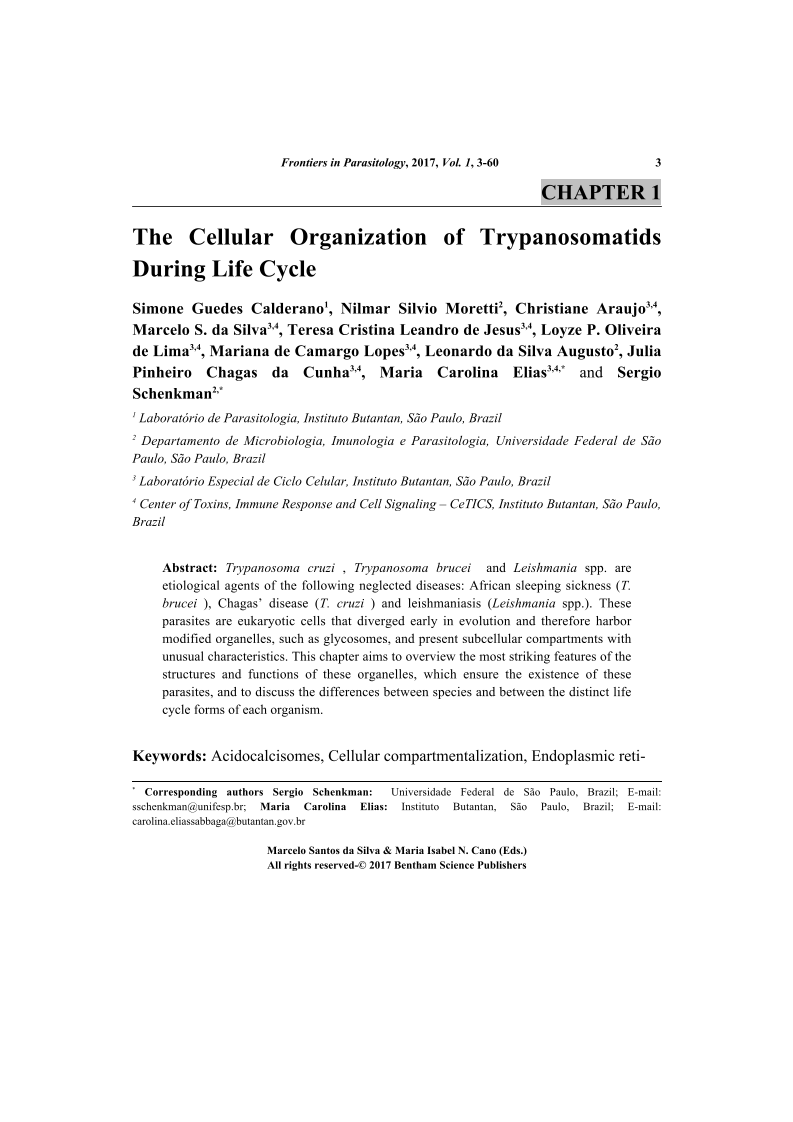The Cellular Organization of Trypanosomatids During Life Cycle

- Authors: Simone Guedes Calderano1, Nilmar Silvio Moretti2, Christiane Araujo3, Marcelo S. da Silva4, Teresa Cristina Leandro de Jesus5, Loyze P. Oliveira de Lima6, Mariana de Camargo Lopes7, Leonardo da Silva Augusto8, Julia Pinheiro Chagas da Cunha9, Maria Carolina Elias10, Sergio Schenkman11
-
View Affiliations Hide Affiliations1 Laboratório de Parasitologia, Instituto Butantan, São Paulo, Brazil 2 Departamento de Microbiologia, Imunologia e Parasitologia, Universidade Federal de São Paulo, São Paulo, Brazil 3 Laboratório Especial de Ciclo Celular, Instituto Butantan, São Paulo, Brazil 4 Center of Toxins, Immune Response and Cell Signaling – CeTICS, Instituto Butantan, São Paulo, Brazil 5 Center of Toxins, Immune Response and Cell Signaling – CeTICS, Instituto Butantan, São Paulo, Brazil 6 Center of Toxins, Immune Response and Cell Signaling – CeTICS, Instituto Butantan, São Paulo, Brazil 7 Laboratório Especial de Ciclo Celular, Instituto Butantan, São Paulo, Brazil 8 Departamento de Microbiologia, Imunologia e Parasitologia, Universidade Federal de São Paulo, São Paulo, Brazil 9 Laboratório Especial de Ciclo Celular, Instituto Butantan, São Paulo, Brazil 10 Laboratório Especial de Ciclo Celular, Instituto Butantan, São Paulo, Brazil 11 Departamento de Microbiologia, Imunologia e Parasitologia, Universidade Federal de São Paulo, São Paulo, Brazil
- Source: Molecular and Cellular Biology of Pathogenic Trypanosomatids , pp 3-60
- Publication Date: February 2017
- Language: English
The Cellular Organization of Trypanosomatids During Life Cycle, Page 1 of 1
< Previous page | Next page > /docserver/preview/fulltext/9781681084053/chapter-1-1.gif
Trypanosoma cruzi , Trypanosoma brucei and Leishmania spp. are etiological agents of the following neglected diseases: African sleeping sickness (T. brucei ), Chagas disease (T. cruzi ) and leishmaniasis (Leishmania spp.). These parasites are eukaryotic cells that diverged early in evolution and therefore harbor modified organelles, such as glycosomes, and present subcellular compartments with unusual characteristics. This chapter aims to overview the most striking features of the structures and functions of these organelles, which ensure the existence of these parasites, and to discuss the differences between species and between the distinct life cycle forms of each organism.
-
From This Site
/content/books/9781681084053.chapter-1dcterms_subject,pub_keyword-contentType:Journal -contentType:Figure -contentType:Table -contentType:SupplementaryData105

